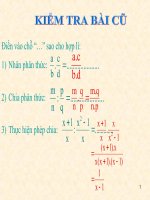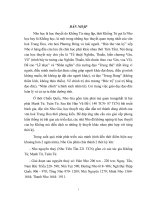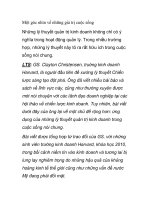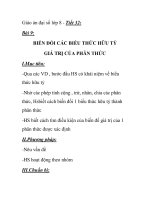THAY ĐỔI NHẬN THỨC VỀ NHỮNG GIÁ TRỊ CỦA PHỤ NỮ MỸ THỂ HIỆN QUA CÁC NHÂN VẬT NỮ CHÍNH TRONG PHIM HOẠT HÌNH DISNEY
Bạn đang xem bản rút gọn của tài liệu. Xem và tải ngay bản đầy đủ của tài liệu tại đây (1.34 MB, 57 trang )
VIETNAM NATIONAL UNIVERSITY, HANOI
UNIVERSITY OF LANGUAGES AND INTERNATIONAL STUDIES
FACULTY OF ENGLISH LANGUAGE TEACHER EDUCATION
GRADUATION PAPER
CHANGES IN THE PERCEPTION OF
AMERICAN WOMEN’S VALUES DEPICTED IN
LEAD FEMALE CHARACTERS OF
DISNEY ANIMATED MOVIES
Supervisor: Ms. Nguyễn Lê Hường (M.A.)
Student: Trần Hà Ngân
Course: QH2010.F1.E21
HANOI – 2014
ĐẠI HỌC QUỐC GIA HÀ NỘI
TRƯỜNG ĐẠI HỌC NGOẠI NGỮ
KHOA SƯ PHẠM TIẾNG ANH
KHÓA LUẬN TỐT NGHIỆP
THAY ĐỔI NHẬN THỨC VỀ NHỮNG GIÁ TRỊ
CỦA PHỤ NỮ MỸ THỂ HIỆN QUA CÁC NHÂN VẬT NỮ
CHÍNH TRONG PHIM HOẠT HÌNH DISNEY
Giáo viên hướng dẫn: ThS Nguyễn Lê Hường
Sinh viên: Trần Hà Ngân
Khóa: QH2010.F1.E21
HÀ NỘI – 2014
DECLARATION
I hereby state that I: (Tran Ha Ngan, QH2010.F1.E21), being a
candidate for the degree of Bachelor of Arts (TEFL) accept the
requirements of the College relating to the retention and use of
Bachelor’s Graduation Paper deposited in the library.
In terms of these conditions, I agree that the origin of my paper
deposited in the library should be accessible for the purposes of study
and research, in accordance with the normal conditions established by
the librarian for the care, loan or reproduction of the paper.
TABLE OF CONTENTS Page
Acknowledgements i
Abstract ii
List of figures, tables, and abbreviations iii
CHAPTER 1: INTRODUCTION 1
1.1. Statement of the problem and the rationale for the study 1
1.2. Aims and objectives of the study 2
1.3. Significance of the study 3
1.4. Scope of the study 3
1.5. Structure of the study 5
CHAPTER 2: LITERATURE REVIEW 6
2.1. Changes in American women’s values 6
2.2. Lead female characters of Disney animated movies 10
CHAPTER 3: METHODOLOGY 12
3.1. Method of data collection 12
3.2. Method of data analysis 17
CHAPTER 4: CHANGES IN THE IDENTITY AND
INEQUALITY ISSUES AMONG DISNEY LEAD FEMALE
CHARACTERS
21
4.1. Identity 21
4.1.1. Character’s appearance 23
4.1.2. Submissiveness 25
4.1.3. Domesticity 28
4.1.4. New Woman 30
4.2. The fight against inequality 37
4.2.1. Inequality at work 37
4.2.2. Inequality in love and marriage 40
4.2.3. Inequality in education and training 42
CHAPTER 5: CONCLUSION 43
References 46
ACKNOWLEDGEMENTS
I wish to express my deep gratitude to my respectful supervisor,
Ms. Nguyen Le Huong (M.A.) for her hearty guidance and her valuable
criticism in the course of my work. My thanks are also due to teachers of the
faculty of English language teacher education for their encouragement and
assistance in the completion of my paper. I also would like to thank my
family, my friends and those who have helped me a lot with their
expectation and hopes for my success.
6
ABSTRACT
Walt Disney studio has been recognized as the premier American
animated studio with a series of popular animated movies about lifetime
adventures of numerous lead female characters. These movies are not only
entertaining, but also express the development of core women’s values in
American society with the changes in the construction of female
protagonists. Beside exploring the main features in the portrayal of lead
female character in Disney animated movies, a closer look of how these
portrayals reflect the differences in American women’s values between two
periods of time, from 1900 to 1990 and from 1990 to 2013 is analysed in this
paper. Observation of artifacts is the primary method for data collection. For
data analysis, the two key methods of feminist analysis based on feminist
film theory and content analysis are adopted. The changes in Disney’s
depiction of lead female characters based on two main themes of identity
and inequality vividly reflects the development in the perception of
American women’s values from 20
th
century to early 21
st
century. Gender
identity is significantly developed in terms of Disney character’s visual
construction and the shift to the “new woman” model, breaking the
conventional “woman sphere” of submissiveness and domesticity. The fight
against inequality of Disney lead female characters also reflects the constant
struggle of American women to diminish gender inequality in three main
spheres of work, love and marriage, and education and training.
7
LIST OF FIGURES, TABLES, AND ABBREVIATIONS
Table 1: Sample list 13
Image 1: Lead female characters of Disney animated movies prior
to 1990
15
Image 2: Lead female characters of Disney animated movies from
1990 to 2013
15
Image 3: Visual construction of Snow White vs. Merida 23
Image 4: Snow White and Aurora’s true love kisses 25
Image 5: Cinderella: Dress transformation 27
Image 6: Snow White and Cinderella - Happy homemakers 28
Image 7: The bookworm Belle 31
Image 8: Snow White and Cinderella – happily ever after 35
Image 9: Tiana: From a waitress to a businesswoman 37
Image 10: Pocahontas’s journey to a new world 38
Image 11: The warrior Mulan 39
Image 12: Headstrong Merida 41
8
CHAPTER 1: INTRODUCTION
1.1. STATEMENT OF THE PROBLEM & RATIONALE FOR THE
STUDY
Since the introduction of the very first animated movie “Snow
White and Seven Dwarfs”, Walt Disney has become one of the best-
known motion picture companies all over the world. It has held a mass
appeal to not only children but also adults as it “went beyond cartoons
and theme parks” (Dakss, 2006). Numerous animated movie characters of
Disney have exerted a strong influence on the audience, including lead
female movie characters, such as Cinderella, Snow White, Mulan,
Pocahontas, etc.
As the world changes, the portrayal of these lead female characters
has gradually adapted accordingly to illustrate the changes in the
perception of what makes a high value woman in the American society.
For example, the massive leap from the image of a traditional woman as a
“homemaker, naive, and lacking in common sense” (Harrison, 2012) in
“Snow White and Seven Dwarfs” to the contemporary image of
American woman with princess Merida of “more independence and free
will” (Zerlina, 2012) in “Brave” reflects significant changes in American
women’s values. Therefore, the images of gender in Disney animated
movies can be considered the depiction of the developing process of
perception of American women’s value.
The portrayal of gender in Disney movies has aroused the interest
of some researchers in terms of both adverse and positive changes
9
through time. However, most of the previous studies primarily focus on
movies released prior to 1990s instead of the modern context. All these
conditions, henceforth, offered the researchers a chance to conduct a
study on “Changes in the Perception of American Women’s Values
Depicted in Lead Female Characters of Disney Animated Movies
(from 20
th
Century to Early 21
st
Century)”
1.2. AIMS & OBJECTIVES OF THE STUDY
First, the paper is aimed to explore the main features of lead female
character’s portrayals in Disney animated movies. Next, a closer look will
be taken at how these portrayals reflect the differences in American
women’s values between two periods of time, from 1900 to 1990 and
from 1990 to 2013.
To gain a comprehensive understanding on this topic, two research
questions will be considered:
1. What are the major American women’s values depicted in lead female
characters of Disney animated movies from 1900 to 1990?
2. What are the major American women’s values depicted in lead female
characters of Disney animated movies from 1990 to 2013, compared to
the previous period?
10
1.3. SIGNIFICANCE OF THE STUDY
Although the study was carried out on a small scale, the researcher
hope that its results could 1) present some common features of portraying
lead female characters that Disney movies employed; 2) present major
American women’s values depicted in lead female characters of Disney
animated movies from 1900 to 1990; 3) present major American
women’s values depicted in lead female characters of Disney animated
movies from 1990 to 2013; 4) present the relationship between media and
society; and 5) help provide certain background knowledge of American
media and gender issues for students researching American studies.
1.4. SCOPE OF THE STUDY
The research primarily concentrates on analyzing lead female
characters of Walt Disney animated movies in the period from 20
th
century to early 21
st
century with the break line of 1990.
Walt Disney studio has been recognized as the premier American
animated studio with a series of popular animated movies that create a
strong influence on audience worldwide including movies about lifetime
adventures of numerous lead female characters like Cinderella,
Pocahontas and Merida. Those particular movies are not only entertaining
but also express the core values of women in the American society
explicitly and implicitly and have “upheld American values and
traditions” through time (Weber, 1998).
11
During more than a hundred years from 20
th
century to early 21
st
century, there have been radical changes to enhance American women’s
status. For example, in the early 1900s, women were mostly homebound,
taking care of family work. This archaic value, however, has been
changed by the rising number of women in the labour force nowadays.
“By 2009 there were as many women as men in the work force, and today
the average wife contributes some 42.2 percent of her family’s income”
(Rosin, 2012).
The year 1990 is chosen as the transition line in the perception of
traditional and contemporary American women’s values depicted in lead
female characters of Disney animated movies. From the beginning of the
1950s onward, the company concentrated on live-action films instead of
feature-length animated movies (Booker, 2011). As a result, after only
four animated movies with lead female characters including Snow White,
Cinderella, Alice and Aurora, released in the period from 1930s to 1950s,
no new feature-length animated movies were introduced until Disney’s
renaissance in the 1990s. The company only resurged when it returned to
make animated films for children, especially those with lead female
characters such as “Beauty and the Beast”, “Mulan”, and “Brave”. In only
23 years from 1990 to 2013, the number has tripled with 13 animated
movies with lead female characters released and warmly welcomed.
1.5. STRUCTURE OF THE STUDY
Chapter 1: Introduction
12
This chapter presents the rationale for the study, scope of the study,
research questions and structure of the study.
Chapter 2: Literature Review
Chapter two provides readers with the definition of the key concepts and
theoretical framework adopted in the study.
Chapter 3: Methodology
This chapter includes the methods used for data collection and data
analysis.
Chapter 4: Results and discussions
Chapter four focuses on presenting major findings after the collection and
analysis of data.
Chapter 5: Conclusion
The chapter contains the summary of major findings, the limitations of
the study and suggestions for further research.
CHAPTER 2: LITERATURE REVIEW
2.1. Changes in American women’s values
The period from early 20
th
century to early 21
st
century witnessed
an obvious change in the perception of American women’s values as a
result of a series of women’s right and feminist movements. Both of them
aimed at “securing equal rights for women and to remove gender
discrimination from laws, institutions, and behavioral patterns” (Gale,
2005). Though “the pace of progress often has been uneven” (Harrison,
1997) women’s right and feminist movements in the USA have
13
developed radically and gained magnificent changes for the women to
access more equality and higher-ranking status recognized by the society.
The traditional ideal image of American women from the early
settlement to the American Revolution in the 18
th
century has long been
depicted as “republican motherhood”, which “linked a woman’s value as
an American citizen to her familial responsibilities” (Bredbenner, 1998).
The greatest distinction between traditional American women and the
later generations is the emphasis on the contribution that women could
make to the society, especially in the period from 1900s to 1960s, the era
of the “new woman”. This term referred to those who were
“better educated and trained than women of the past, willing and able to earn
her living, frequently in a job formerly monopolized by men and hence under
less pressure to marry, holding independent view on all sorts of subject, and
above all, less dependent on man both economically and intellectually”
(Riegel, 1971).
The roaring twenties was marked by numerous significant changes
in the United States including the beginning of transitions in the
perception of women’s roles, status and values in the society. The most
outstanding event of this period was women being granted the right to
vote for the first time in the history after a long struggle for female
suffrage for nearly six decades. Since then, the traditional role of a typical
American woman as daughter, wife and mother has gradually changed.
Women’s lives no longer revolved only around family and housework
because they could also take part in many aspects of social life.
Three decades later, during World War II, American women’s role
in the society continued to develop, leading to the transition in their
values. More and more women joined in the labour force. In the past,
women tended to dedicate their whole lives to their family and farm work
14
but during the war, the “Roise the Riveter”
1
model became popular as
“soon they were successfully doing things only men had done before”
(Bryant, 2002), especially in “defense industries of aircraft manufacture,
ship building, munition and pioneer electrics” (Weatherford, 2009).
Women of this time gained more independence and their single role as a
homemaker moved to double roles as a woman of the workplace like any
typical American man. “For many women, World War II became a
symbol of freedom. It was a time where women were no longer forced
into the roles society had created for them” (Harrison, 1997). Women’s
values, once determined by their dedication and loyalty to family’s life
shifted to other qualities like intelligence or abilities at work.
Dual public and private roles of American women still existed in
the post war decades though gender inequality remained. After the war,
women were encouraged to return to the “woman sphere” with four chief
characteristics of “piety, purity, submissiveness and domesticity” (Welter,
1966). An example for this ironic vicious cycle was demonstrated by
Douglas (2004) as
“the popular press, at the government’s instigation began to encourage women
to return to the home and family despite formerly exhorting the image of
working women in factory during World War II. In addition, women were still
constrained by social’s fear that they could not fulfill their double shifts.
However, American women kept striking for their freedom and equality by a
wide range of feminist movements focusing on “dismantling workplace
inequality, such as denial of access to better jobs and salary inequity, via anti-
discrimination laws” (Bryant, 2013)
which illustrated their desire to gain more recognition in the society.
1 A cultural icon of the United States, representing the American women who worked in factories
during World War II. Rosie the Riveter is commonly used as a symbol of feminism and women's
economic power.
15
Since the 1990s, the perception of American women’s values have
comprehensively shaped contemporary American women’s value as
American women lived a “very different life in the 1990s than they did in
the 1950s and earlier” (Bryant, 2002). This has been the period that
American women have gained more self-reliance, independence, freedom
and equality than ever before. Women becoming breadwinners is not an
uncommon story in America’s society anymore. The role of traditional
woman as inferior to man in family or at work has become unsuitable in
the current context. Women have become less dependent on men, which
is demonstrated by the increase in the age of marriage. According to the
US census bureau, the median age for first marriage of female increased
from twenty in 1950 to twenty six in 2000 (US census bureau, 2010).
Nearly 46% of women in labour force in 1996 (Chadwick, 1999) was a
sign of significant renaissance of women in public sphere. They are the
illustration for the current picture of American women who have long
struggled for their independence from their housewife roles. Women can
even beat men in the aspects that used to be for men only like out-earning
in family, in nearly a quarter of households with spouses between 18 and
65 years old (Lambert, 2013) in 2010.
After a century of critical women’s right and feminist movements,
American women have successfully enhanced their values in family as
well as in society. Women have gradually gained more independence,
freedom and equality thanks to the participation in education and training
and in the labour force. Not only have they joined in numerous aspects of
the society but American women have also obtained outstanding
achievements in the fields that used to be dominated by men. Hence, the
16
archaic perception of American women values strongly linked with their
inferior status to men has shifted to the 21
st
-century contemporary
American women’s image of more self-reliance and freedom.
2.2. Lead female characters of Disney animated movies
As movies can act as a mirror in many aspects of life, the
American women’s values can be interpreted via more than 80 years of
Disney animated movies with their lead female characters. In the early
time, the lead female characters are mainly the princesses adapted from
famous fairy tales like “Cinderella”, “Sleeping Beauty”, and “The Little
Mermaid”, but gradually the producers only kept the main plot of the
tales and added new elements to make the stories more appealing.
Sometimes, the plot of the story can even be reversed and become
completely surprising like in the movie “The Princess and the Frog”, in
which a normal African-American girl after kissing a prince in the form
17
of a talking-frog also turns into a frog. Besides lead characters in roles of
princesses, Disney animated movies have also presented other lead
female characters that do not have any royal tittles like Mulan. Another
feature of the lead female characters in Disney movies is the presence of
not only white women but also other races including Asian like Mulan
and Virginia Indian like Poncahontas. This offers the researcher a chance
to have a better understanding on the reflection of American women’s
values of different ethnic groups in the United States.
For the earlier time, the perception of women’s values via lead
female characters in Disney animated movies has the tendency to be
passive as shown in previous studies. For example, in “Images of gender,
race, age and sexual orientation in Disney feature length animated films”,
one of the characteristics of female characters pointed out is “women are
domestic and likely to marry” (Towbin, Lund & Tanner, 2008). The
previous studies share the common conclusion that “the message
portrayed to young girls across the globe remains the same: women are
inferior to men” (Gold, 2012). These interpretations partly reflect the
situation of American’s women’s perceived values in the period from the
1900s to the 1990s. However, these studies have not illustrated the rapid
changes that Disney movies have made recently, which reflect the
changes in the perception of women’s values. Still being loyal to the
motif of fairy tales, but Disney animated movies have reflected closer
portrayals of the modern women’s values of freedom and mobility.
Pocahontas, who makes a magnificent and adventurous trip, is an
example of a female protagonist that has never been introduced in earlier
Disney movies of the same genre. The changes in the portrayal of gender
in Disney movies, therefore, could be a valuable source of reference for
18
the changes in the perception of American women’s values in the past
century.
19
CHAPTER 3: METHODOLOGY
Because the essence of this thesis is primary research, observation
of artifact as the method of data collection and data analysis based on
feminist film theory and contents are adopted as the tools to propose new
findings.
3.1. Method of data collection
3.1.1 Research subjects
Lead female characters in Disney animated movies from 1930 to
2013 will be taken as the subjects for the study. As the study only focuses
on movie characters, research participants will not be included.
3.1.2 Basic features of the research subjects
Research subjects are taken from animated feature-length movies
released by Disney studio from 1930 to 2013. These movies evolve
around the lives of thirteen different lead female characters. As the thesis
concerns women’s values, only lead female characters portrayed as adult
females are analyzed. Some movies of the same lead female characters
are split into multiple parts (from two to three parts) like “Pocahontas”,
“Pocahontas II: Journey to a New World”. Movies from animated Disney
movies list (Retrieved from />disney-movies.asp) that offer the above features will be analyzed in the
research.
20
3.1.3. Sampling
Since the number of movies with lead female characters of Disney
is limited, 100% of the research subjects containing twelve lead female
characters in seventeen Disney animated movies will be analyzed.
The samples are listed in the following table
Sample List
No. Lead female
characters
Tittles Original Release
date
1 Snow White Snow White and the Seven Dwarft 1937
2 Cinderella Cinderella 1950
Cinderella II: Dreams Come True 2002
Cinderella III: A Twist in Time 2007
3
Aurora
Sleeping Beauty 1959
4 Ariel The Little Mermaid 1989
The Little Mermaid III: Ariel’s
Beginning
2008
5 Belle Beauty and the Beast 1991
Beauty and the Beast II: The
Enchanted Christmas
1997
6 Pocahontas Pocahontas 1995
Pocahontas II: Journey to a New
World
1998
7 Mulan Mulan 1998
Mulan II 2004
8 Tiana The Princess and the Frog 2009
9 Rapunzel Tangled 2010
21
10 Merida Brave 2012
11 Elsa Frozen 2013
12 Anna
Lead female characters of Disney animated movies prior to 1990
22
Snow White Cinderella Aurora Ariel
Lead female characters of Disney animated movies from 1990 to 2013
Belle Pocahontas Mulan Tiana
Rapunzel Merida Elsa Anna
23
3.1.4. Data collection methods
Observation of artifacts will be the primary method for data
collection process. According to Le (2012), artifacts can be of “popular
culture like books, films and videos.” Observation of artifacts enables the
researcher to access a large amount of rich data and have more time to
examine the artifacts with repeated observations to gain a deeper and
multilayered understanding on the subjects.
Artifacts used in this paper are the movies as mentioned above and
the lead female characters in these movies will be observed in terms of
appearance, personality, identity, inequality, interaction, and institution.
24
3.2. Method of data analysis
As the research aims to analyze American women’s values
depicted in Disney lead female characters from 20
th
century to 21
st
century, the key method of data analysis is feminist analysis based on
feminist film theory. Another approach that supports the interpretation of
movie’s character is the application of content analysis.
3.2.1. Feminist Film Theory
Feminist movements have brought about enormous impacts on
film theory, noticeably after the second wave feminism (1960s – 1980s).
In the United States, feminist film theory initially emerged in the 1970s
and has developed rapidly since then. This theory is based on a
sociological approach which “locates images, roles and representation of
women in cinema as phenomena reflecting, or determined by, the position
of women in the ‘real’ world or the wider society” (Haytham, 2012).
Issues of presentation of the women have always been the crucial
concerns of feminist film theory (Smelik cited in Cook, 1999).
Feminist film theory involves a theoretical combination of
sociological analysis, semiotics, Althusserian Marxism, and Lacanian
psychoanalysis. However, Althusserian Marxism, and Lacanian
psychoanalysis mainly aim to identify the effects of movie’s ideology on
spectators that shape the desires of the audience’s social values rather
than the reality reflected in movies. Therefore, only semiotics and
sociological analysis are employed as the tools to analyze Disney
animated movies in the perspective of feminist theory reflecting changes
in American women’s values from 1900 to 2013.
25









